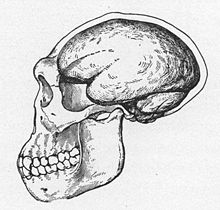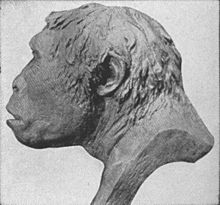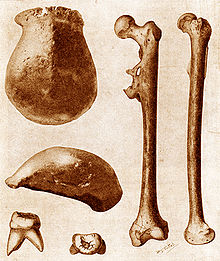- Java Man
-
"Pithecanthropus erectus" redirects here. For the song and album by that title, see Pithecanthropus Erectus (album).
Java Man (Homo erectus erectus) is the name given to fossils discovered in 1891 at Trinil - Ngawi Regency on the banks of the Solo River in East Java, Indonesia, one of the first known specimens of Homo erectus. Its discoverer, Eugène Dubois, gave it the scientific name Pithecanthropus erectus, a name derived from Greek and Latin roots meaning upright ape-man.
Contents
History and significance
Dubois' find was a very incomplete specimen, consisting of a skullcap, a femur, and a few teeth. There is some dissent as to whether all these bones represent the same species.[1] A second, more complete specimen was later discovered in the village of Sangiran, Central Java, 18 km to the north of Solo. This find, a skullcap of similar size to that found by Dubois, was discovered by Berlin-born paleontologist GHR von Koenigswald in 1936. Many more finds have subsequently been made at the Sangiran site,[2] although official reports remain critical of the site's "poor" presentation and interpretation.[3]
The new date of the Mojokerto child, Dr. Swisher's group [of the Institute of Human Origins in Berkeley] has determined, is about 1.81 million years, and the Sangiran fossils are about 1.66 million years old. The oldest African Homo erectus fossils, found at Koobi Fora in Kenya, has been dated at about the same age as the Mojokerto child.[4]
Until older human remains were discovered in the Great Rift Valley in Kenya, Dubois' and Koenigswald's discoveries were the oldest hominid remains ever found. Some scientists of the day suggested[5] Dubois' Java Man as a potential intermediate form between modern humans and the common ancestor we share with the other great apes. The current consensus of anthropologists is that the direct ancestors of modern humans were African populations of Homo erectus (possibly Homo ergaster), rather than the Asian populations exemplified by Java Man and Peking Man.
See also
- Peking Man
- List of fossil sites (with link directory)
- Homo erectus soloensis
References
External links
- How Man Began
- The story of Eugène Dubois's excavations on Homo erectus in Central Java (Youtube video)
- BBC Horizon 34x03 Out of Asia 1997
Part of the series on Human evolution Humans and Proto-humansHomo: H. gautengensis · H. habilis · H. rudolfensis · H. georgicus · H. ergaster · H. erectus (H. e. erectus · H. e. lantianensis · H. e. palaeojavanicus · H. e. pekinensis · H. e. nankinensis · H. e. wushanensis · H. e. yuanmouensis · H. e. soloensis) · H. cepranensis · H. antecessor · H. heidelbergensis · Denisova hominin · H. neanderthalensis · H. rhodesiensis · H. floresiensis · Archaic Homo sapiens · Anatomically modern humans (H. s. idaltu · H. s. sapiens)Categories:- Hominin fossils
- Paleoanthropology
- Prehistoric Indonesia
Wikimedia Foundation. 2010.



